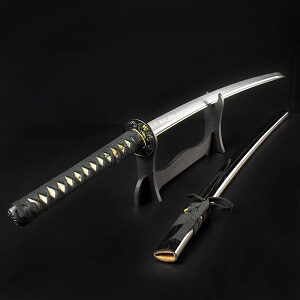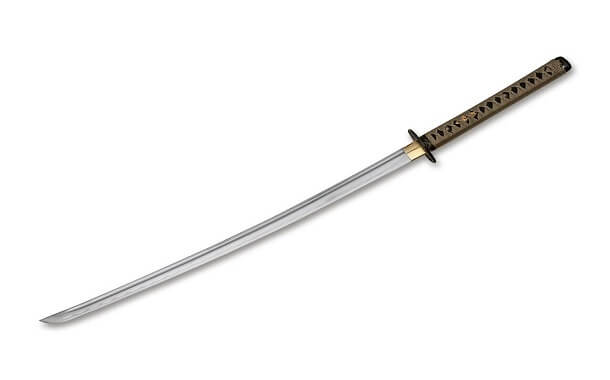How Much Does a Katana Cost?
Katana is a type of Japanese sword, often referred to as the samurai sword. The term katana can also be used for any curved Japanese sword with a blade length greater than 60 cm. It is often used incorrectly for Japanese swords in general.
The Katana sword is characterized by its properties: It is curved, light, with a single blade, with a circular or square guard, and with a handle long enough to be held with both hands. Historically, it became inseparable from the samurai of the feudal period of Japan and became known for its ability to cut and its sharpness.
Knowing what type of katana sword you want is very important before buying one. Before setting a budget do your research, as they may differ in type depending on the used steel type, whether it is handcrafted or manufactured, as follow:
- Functional purpose – it is a high-quality Japanese Katana sword made of high-carbon steel, and is battle-ready;
- Decorative purpose – it is a decorative Katana made out of stainless steel, so it won’t rust too quickly;
- Testing purpose – it is a Katana of average quality made out of functional full-tang steel;
- Sparring purpose – it is a Katana of good quality steel but without sharp edges, used in martial arts training;
- Value purpose – it is a collection item; some may call it a “real Katana sword” and is made with authentic tamahagane steel.
How much does a katana cost?
A Katana may cost as low as $50 or as much as $25,000 or more, and even millions of dollars if we talk about an antique piece.
As we said before, first you must consider your needs, as there are several types of Katana swords that range in price greatly.
You can buy a cheap Katana from $50 to $2,000. There are many excellent functional swords at an average of $100, that are both versatile and sharp.
You might also like our articles on the cost of Taekwondo classes, kickboxing classes, or martial arts classes.
Chinese-made productions can also offer a “reasonably traditional” sword costing from $1,000 to $4,500.
Authentic Katanas are called Nihonto and are handmade in Japan. The weapon ownership laws from Japan are the toughest in the world and the sword production is strictly regulated. The average price for an authentic Katana is around $7,000-$8,000, but usually their cost starts from $5,000 and goes up to between $12,000 to $25,000 and more.
Factors that affect the cost of a Katana sword
One can expect to pay between a few hundred dollars and a few thousand dollars, but first, you should be able to make the difference between a low-quality and a high-quality Katana. Whether it is manufactured or handmade, the material and the style of the katana will all affect its final cost. Here are some of the factors that will influence the price:
- A handcrafted Katana will definitely be more expensive than a manufactured one;
- Where it is made – a handcrafted Katana from Japan will be more expensive than one handcrafted in China, even if we talk about a swordsmith trained in Japan;
- The sword smith’s skills and prestige or the company’s reputation;
- The style of the Katana you want to buy will also affect the cost as they can be: Daisho, Tachi, Shin-Gunto, and Uchigatana;
- The blade material – there is a high difference between a blade made out of the least expensive carbon steel and a Katana made from Tamahagane, as the latter is of a huge rarity but also cultural significance;
- The tempering process and level of polish;
- The details of the hamon and whether it is a real hamon or not;
- Blade shaping;
- Handle material; Samegawa quality; Tsuka Ito material/quality; Sageo quality;
- Furniture pieces, material, production, final fit, and finish;
- Saya profile, material, fit, and finish;
How much does ancient Katana cost?
In Japan, the sword is a unique object, weapon, and icon at the same time. Nowhere in the world has the sword itself been studied and carried so close to perfection as here. The blacksmiths from the beginning of the Heian period (794-1185 AD) and Kamakura (until 1333), as well as those from the Muromachi period (1333-1530), reached such perfection in the processing of steel that their art remained unmatched to this day, secrets being revealed only to members of their own families.
The swords created at that time are a mystery even to modern science, their cutting being almost indestructible unless it meets a similar sword. A master of Ken-Jutsu, the art of sword-making in samurai, can cut iron bars or wooden poles with such a weapon. The most famous Japanese blacksmith was Goro Masamune (1264-1343), a sword made by him being practically perfect and its value is incalculable.
Most of the pieces are in the Japanese national heritage, and for the few remaining in private collections huge offers from Japanese magnates were rejected, who were willing to pay as much as $20 million for a piece.
In 1992, Dr. Walter Ames Compton sold his collection of 1000 swords for $8 million dollars. Just the Kamakura Katana was sold for more than $400,000.
A short history of the Katana
 As a result of changes in combat conditions, thus requiring higher speed, the katana was created during the Muromachi period (1392–1573). The speed was demonstrated by the katana with its blade placed upward, thus allowing the samurai to pull the sword out of the sheath and cut off the enemy in one strike. Before, the curved sword was carried by the samurai with the blade down. But this method was useful to the samurai only in his daily life.
As a result of changes in combat conditions, thus requiring higher speed, the katana was created during the Muromachi period (1392–1573). The speed was demonstrated by the katana with its blade placed upward, thus allowing the samurai to pull the sword out of the sheath and cut off the enemy in one strike. Before, the curved sword was carried by the samurai with the blade down. But this method was useful to the samurai only in his daily life.
The length of the blade varied considerably throughout history. In the late 14th and early 15th centuries, the blade of the katana used to be between 70 and 73 cm long. At the beginning of the 16th century, the average length was much closer to 60 cm, but at the end of that century, it reached up to 73 cm again.
Katana is often paired with wakizashi, a similar but shorter sword worn by warriors. It is rarely paired with tantō, a sword of the same shape but the length of a knife. The couple formed by the katana and wakizashi were called daishō and represented the social power and honor of a samurai.
Composition
The composition of the steel used for katana varies from blacksmith to blacksmith depending on the iron ore used. In a formula known to be used during World War II the composition of the elements was as follows:
- Iron 95. 22% to 98. 12%
- Carbon 0. 10% to 3. 00%
- Copper 1. 54%
- Magnesium 0. 11%
- Wolfram 0. 05%
- Molybdenum 0. 04%
- Titanium dioxide 0. 02%
- Silicon variable quantities
- Various compounds depending on the percentages used
An authentic Katana sword is made of Japanese steel called “Tamahagane”. Forging a Katana blade could take hours or days, the process being considered a sacred art. As with many other complex processes, several manufacturers/artists were involved, not just one craftsman. There is a blacksmith to make the hardness of the sword, often a second blacksmith (apprentice) to bend the metal, a grinding specialist, and even a specialist to make the edge of the blade and sharpen it. Many times, there were specialists for making the handle, and sheath and separating portions of the sheath from the handle, the tsub.


Leave a Reply
Want to join the discussion?Feel free to contribute!